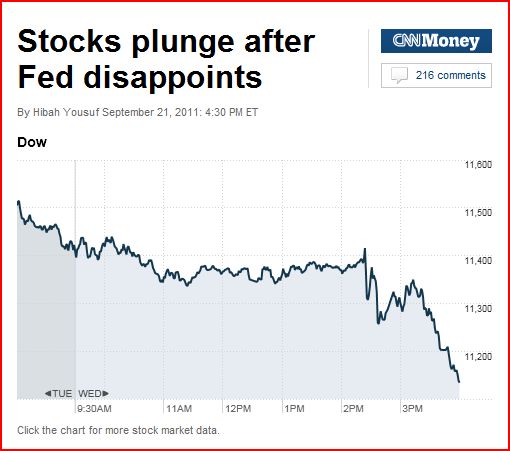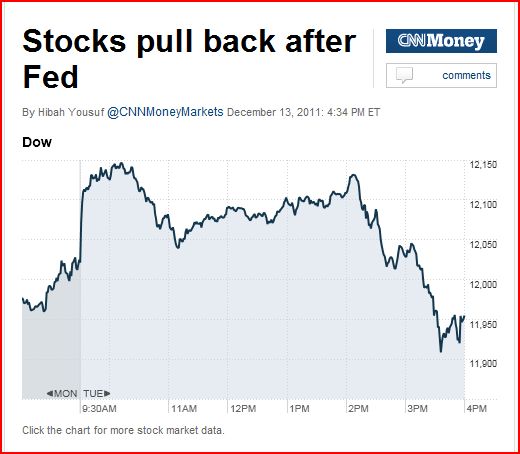13 Responses to “Two graphs”
Leave a Reply
A slightly off-center perspective on monetary problems.

Two graphs:
And:
Let’s see if we can’t do better in January, by which time the three hawks will be gone.
BTW: Fed announcements come at 2:15 pm.
Tags:
This entry was posted on December 13th, 2011
and is filed under Monetary Policy.
You can follow any responses to this entry through the RSS 2.0 feed.
You can leave a response or Trackback from your own site.
13 Responses to “Two graphs”
Leave a Reply


13. December 2011 at 15:54
You’re missing the point – the Fed is surely wildly happy with the effects of today’s action. Just look here:
http://finance.yahoo.com/q/ta?s=GLD+Basic+Tech.+Analysis&t=5d
In the past 5 days they have tanked the price of gold by 7%… While only killing the S&P 3-4%. They broke gold down below the 1650 support line (steady at 1625), which means they can beat the crud out of it and force margin calls across the commodities spectrum. They intend to beat the crud out of the leveraged dollar-carry-trade crowd (those who bet on commodities and against stocks or the dollar).
But certainly the Fed is above such things… Or not.
13. December 2011 at 17:11
Statsguy, Destroying the economy to go after gold bugs is like dynamiting a house to get rid of termites.
You’re probably just joking. But I can never tell with commenters around here.
13. December 2011 at 17:24
It would be quite ironic if the Fed was systematically pursuing a deflationist policy to hurt the gold bugs. I’d rather they gave the gold bugs what’s good for them, though.
13. December 2011 at 17:27
It does feel better when you stop hitting yourself in the head with a hammer.
13. December 2011 at 20:40
Let me retitle this essay…
More than half of Nobel prizes go to functionally retarded liberals.
Perhaps conservatives should take the money and denounce the prize until Nobel outs itself fails accordingly and dies a shit death.
Personally I view the awards to conservatives in the same vein as the nytimes times throwing a blue Mon nod to a conservative argument.
The prize isn’t that big… some hard core wrench hitting hedge fund guys should start their own pro raw market Nobel.
13. December 2011 at 20:43
Benji to be frank hitting you in the head with a hammer feels pretty good too… hell of feels great.
13. December 2011 at 22:51
Intra-day moves are one thing, but December was 8% higher than September. So if you are testing your entire economic theory on the basis of stock market moves then over the slightly longer horizon of a few hours, things are getting better in the US.
14. December 2011 at 03:03
Excuse my ignorance, but does anyone know the policy views of the members coming in from Cleveland, Richmond, Atlanta, and San Francisco? Mainly, if they’d be open to NGDP targeting, or at least more aggressive action?
14. December 2011 at 05:15
Stocks moved and the dollar strengthened a bit but curiously Treasuries barely did. Yields on the 10-year had fallen to 1.98 before the announcement and finished the day at about 1.97.
14. December 2011 at 08:11
@ Bryan, the new members are 3 dovish 1 hawkish, a notable dovish tilt from current balance.
http://www.garydhalbert.com/2011/12/05/the-fed-is-qe3-coming-in-january-2/
14. December 2011 at 08:12
@ Scott, I’m almost always half joking. However, if you believe in revealed preference theory for institutions, then the Fed’s actions are far more consistent with preserving the value of the dollar vis a vis the commodity complex than preserving economic productivity.
Gold broke below 1600 today, down to 1586 right now, with break below 1600 triggering massive sell stops, which should be reinforced by a wave of margin calls on levered gold longs and further reinforced by momentum chasing algorithms. The 50 day moving average will now solidly dip below the 100 DMA, which hasn’t happened for a couple years (50 keeps bouncing off the 100 as gold moves in an upward channel). The Fed just broke the bounce. If a downtrend holds, the 50 could break below the 200, which would flatten gold price for 6 to 12 months.
http://finance.yahoo.com/q/ta?s=GLD&t=5y&l=on&z=l&q=l&p=m50%2Cm100%2Cm200&a=&c=
Do I believe chartist tea leaf reading? No and yes. I believe it only because enough other people believe it that it often comes true.
Do I believe the Fed is watching the price of gold? Yes, I do. Why? Because all of their critics (strong dollar phreaks) are locking onto gold as the savior from fiat printing death. I suspect the Fed is going to use this opportunity to crush them while it can, at least until the real economy can’t take the pain.
Stupid? Yes. Then again, it sure seems stupid that the Fed won’t commit to a specific inflation (or, better, NGDP) target and insists on “flexibility”, even though every mathematical model keeps saying that’s a bad idea. So, what does the Fed know (or think it knows) that causes it to want this ‘flexibility’?
14. December 2011 at 12:53
I found this gem on Jim Hamilton’s blog that I would like to point you to, on the efficacy of monetary policy:
http://www.econbrowser.com/archives/2011/12/fomc_statement.html
Basically,
1) Jim Hamilton thinks the Fed could be doing more. This is a highly respected time-series econometrician, one who Sargent and Sims would call a “real economist”, coming out in favor of a Sumnerian proposition. Not a bad start.
2) Hamilton thinks the Fed thinks that it could do more. Also consistent with Scott’s view of Bernanke.
3) Hamilton thinks that the main reason that the Fed isn’t doing more, is that the Fed would find it hard to justify expansionary actions in the language of inflation targeting. CPI inflation is about on target, year-over-year.
This sort of goes back to our discussion over Thanksgiving, Scott, of whether P or NGDP is the better nominal guide to the economy. Looking at P right now simply does not give the Fed the “right” guidance on the state of the economy while looking at NGDP would. It’s just yet more evidence that if you want the most sufficient statistic to summarize demand, it’s not P, it’s NGDP. Since monetary policy primarily acts to influence demand, the target variable ought to be NGDP, not P. You know all of this already but I think it bears repeating.
Unfortunately Hamilton continues to frame his advice to the Fed in inflation terms, but it’s a start that he thinks the Fed still has plenty of options to stimulate demand at the ZLB.
14. December 2011 at 19:13
Morgan, Recently you seem to be leaving comments at the wrong posts.
James; you said;
“Intra-day moves are one thing, but December was 8% higher than September. So if you are testing your entire economic theory on the basis of stock market moves then over the slightly longer horizon of a few hours, things are getting better in the US.”
The EMH says the immediate reaction is what matters. But no, I’m not basing my ‘entire economic theory’ on those two graphs, as I’m pretty sure you already know.
Rajat, I have no explanation for that.
Statsguy, Yes, the FOMC will be in Bernanke’s pocket next year. It’s all up to him.
I don’t follow your commodity targeting comment. They let commodity prices soar in 2008, and then fall more than in half in 2009.
Integral, Thanks for the link. But here’s what I don’t get. The Fed wasn’t targeting inflation in 2007 and 2008. They cut interest rates sharply in 2007 and January 2008 when inflation was way above 2%. (This is well before the first banking crisis.) Why can’t they stimulate now, with an economic crisis and TIPS spreads below 2% on the 5 year?